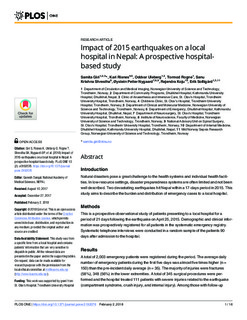| dc.contributor.author | Giri, Samita | |
| dc.contributor.author | Risnes, Kari Ravndal | |
| dc.contributor.author | Uleberg, Oddvar | |
| dc.contributor.author | Rogne, Tormod | |
| dc.contributor.author | Shrestha, Sanu Krishna | |
| dc.contributor.author | Nygaard, Øystein Petter | |
| dc.contributor.author | Koju, Rajendra | |
| dc.contributor.author | Solligård, Erik | |
| dc.date.accessioned | 2018-03-05T09:03:40Z | |
| dc.date.available | 2018-03-05T09:03:40Z | |
| dc.date.created | 2018-03-01T12:30:43Z | |
| dc.date.issued | 2018 | |
| dc.identifier.issn | 1932-6203 | |
| dc.identifier.uri | http://hdl.handle.net/11250/2488478 | |
| dc.description.abstract | Introduction
Natural disasters pose a great challenge to the health systems and individual health facilities. In low-resource settings, disaster preparedness systems are often limited and not been well described. Two devastating earthquakes hit Nepal within a 17-days period in 2015. This study aims to describe the burden and distribution of emergency cases to a local hospital.
Methods
This is a prospective observational study of patients presenting to a local hospital for a period of 21 days following the earthquake on April 25, 2015. Demographic and clinical information was prospectively registered for all patients in the systematic emergency registry. Systematic telephone interviews were conducted in a random sample of the patients 90 days after admission to the hospital.
Results
A total of 2,003 emergency patients were registered during the period. The average daily number of emergency patients during the first five days was almost five times higher (n = 150) than the pre-incident daily average (n = 35). The majority of injuries were fractures (58%), 348 (56%) in the lower extremities. A total of 345 surgical procedures were performed and the hospital treated 111 patients with severe injuries related to the earthquake (compartment syndrome, crush injury, and internal injury). Among those with follow-up interviews, over 90% reported that they had been severely affected by the earthquakes; complete house damage, living in temporary shelter, or loss of close family member.
Conclusion
The hospital experienced a very high caseload during the first days, and the majority of patients needed orthopaedic services. The proportion of severely injured and in-hospital deaths were relatively low, probably indicating that the most severely injured did not reach the hospital in time. The experiences underline the need for robust and easily available local health services that can respond to disasters. | nb_NO |
| dc.language.iso | eng | nb_NO |
| dc.publisher | Public Library of Science | nb_NO |
| dc.rights | Navngivelse 4.0 Internasjonal | * |
| dc.rights.uri | http://creativecommons.org/licenses/by/4.0/deed.no | * |
| dc.title | Impact of 2015 Earthquakes on a local hospital in Nepal: A Prospective Hospital-based Study | nb_NO |
| dc.type | Journal article | nb_NO |
| dc.type | Peer reviewed | nb_NO |
| dc.description.version | publishedVersion | nb_NO |
| dc.source.journal | PLoS ONE | nb_NO |
| dc.identifier.doi | 10.1371/journal.pone.0192076 | |
| dc.identifier.cristin | 1569753 | |
| dc.description.localcode | © 2018 Giri et al. This is an open access article distributed under the terms of the Creative Commons Attribution License. | nb_NO |
| cristin.unitcode | 194,65,25,0 | |
| cristin.unitcode | 194,65,15,0 | |
| cristin.unitcode | 194,65,30,0 | |
| cristin.unitname | Institutt for sirkulasjon og bildediagnostikk | |
| cristin.unitname | Institutt for klinisk og molekylær medisin | |
| cristin.unitname | Institutt for nevromedisin og bevegelsesvitenskap | |
| cristin.ispublished | true | |
| cristin.fulltext | original | |
| cristin.qualitycode | 1 | |

